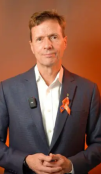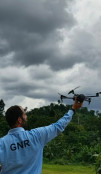Young Panamanians and Europeans walk along the Camino Real for historical, intercultural and environmental education

More than 25 members of Youth Sounding Board (Spanish: Altavoz Juvenil, young Panamanians in associations) and Team Youth Europe (young Europeans in embassies and cultural centres), joined together for a tour of the Camino Real in the framework of the EU project Colonial Routes, Natural Crossroads, which aims to promote intercultural dialogue and environmental and economic sustainability through cultural heritage.
The journey on 27 February began with a land transfer to Puerto Nuevo Vigia, in the province of Colón, and from there by boat to the beginning of the section of the Camino Real enabled by the Community Based Organisation (CBO) of Quebrada Ancha, in the Chagres National Park.
During the walk, CBO guides and experts from the European project explained the history of the Camino Real, as well as the geology, flora and fauna of the area. The young people learned about the construction of the road in parts, through tenders similar to those of today, imagined the passage of the lines of mules loaded with Peruvian gold bound for Spain or pirate ships, observed parts of the Camino Real on private land, and even listened to horror stories. The day culminated with a visit to an island in Lake Arajuela, where the young people were able to observe another stretch of the Camino Real, semi-submerged in the lake, and even find the remains of mule shoes, nails and glass bottles.
Many of the young Panamanians were surprised to discover this side of their country's history:
I am surprised. For me, Colon had always been just the port and the old town, but now, that is no longer the case.
José Alejandro, Youth Sounding Board member and founder of Dame Un Chance
At the CBO cultural ranch in Quebrada Ancha, the youth was able to meet members of the community and their important work in the recovery, maintenance and tourist exploitation of the Camino Real. In addition, they enjoyed typical gastronomy, and supported local crafts and agriculture.
This visit not only broadened the knowledge about the colonial roads, but also offered the assistants a valuable opportunity to establish intercultural relations and explore ways of collaboration. In particular, a space for dialogue was opened on how to raise awareness among Panamanian youth about colonial roads. For the latter task, two groups were formed, combining members of the Youth Sounding Board and Team Youth Europe, in order to offer different perspectives and experiences.
Participants shared the impact the walk had on them. In doing so, they recognised the importance of first-hand experience for people to have an unforgettable learning experience and connect with history, with the potential to then become ambassadors for the trails. They highlighted that access to the trails from Panama City is difficult, so school field trips are limited to Summit Park and the Panama Canal. At university level, the frequency of tours is even lower.
Team Europe Youth members shared examples of history and culture education in European countries: visits to museums (Italy); workshops, films with debates, documentaries on TV (France); family tree (Netherlands); or interviews with people involved in historical events (Hebras de paz initiative in relation to the civil war in Spain).
All people agreed that the teaching of the paths should start before adolescence, taking the example of Guna Yala where children are involved from an early age.
The Youth Speaker discussion highlighted that history classes focus on the republican era, with little attention devoted to pre-Columbian or colonial times, and adopt a sometimes Eurocentric view of the inter-oceanic route and international trade. The lack of teaching materials for independent or complementary study was also noted. Reaching communities in the interior is an even greater challenge because of the digital divide: they do not have a good connection to be able to listen to podcasts or download books and films.
The importance of professors’ initiatives was recognised, as well as innovative ones. Success stories were shared, such as the courses for teachers in Panama Viejo, the sketchbook of the El Caño centre, the contents generated by CIHAC AIP, INDICASAT or SENACYT.
As a result, young Panamanians and Europeans made various recommendations that encourage awareness and exploration of the Camino de Cruces and Camino Real:
-
Content creation:
-
Written educational material
-
Explanatory videos and documentaries on the route: highlighting that it was the precursor to the Canal, interventions by people from the surrounding communities
-
Podcasts on the history of the routes
-
Plays or musicals
-
Social media: participants committed to disseminate from their accounts (Youth Speaker, EU Member States Embassies), and recommended to the community to create interactive content.
-
Activities for schools and universities:
-
Teaching history from a Panamanian point of view since pre-Columbian times, linking Panamanian history to world history.
-
Games/missions/tasks in different subjects (maths, biology, history...), including painting (such as hopscotch) or recreating the trails with handicrafts
-
Talks about the trails, including by representatives of communities
-
Excursion, e.g. integrated in the Panama Canal (the most common)
-
A scavenger hunt to find out what happened at each point on the trail
-
Combine lessons with practical questions, e.g. some students are tasked with going to the Canal Zone and taking pictures of objects that were American.
-
Road rallies
-
Museums and professionals:
-
Create interpretive centre for the trails, with interactive elements.
-
Enhance the narrative about the trails in existing museums, such as Panama Viejo and Casco Antiguo.
-
Provide museums - especially outside Panama City - with sufficient resources for infrastructure improvements and tools.
-
Providing training for schools, universities, museums, communities and tour operators on the history, preservation and teaching of the trails, with a special focus on ensuring generational renewal.
-
Partnership with organisations and personalities
-
Talks and visits with Youth Speaker member organisations
-
Promote the Panamanian Trails, including at the international level, as the Inca Trail
-
Request the Ministry of Education and other institutions (SENACYT, ITSE, etc.) to involve young people in teaching about the trails.
-
Family: raise awareness among parents e.g. through the parents' school by suggesting the trails as a holiday or weekend plan.
-
Associations/clubs working with children, e.g. community boards (organising happy summer), Boys Scouts, Girl Guides, sports clubs, science mentoring organisation
-
Individual experts such as Maritza Lasso
-
Influencers such as Pasaporte inédito (specialising in history and culture)











